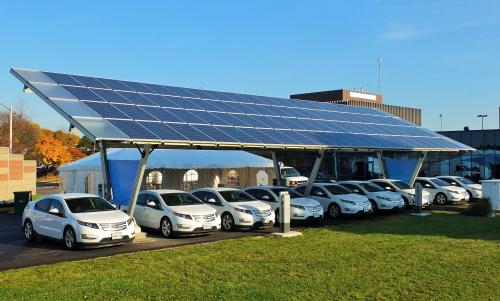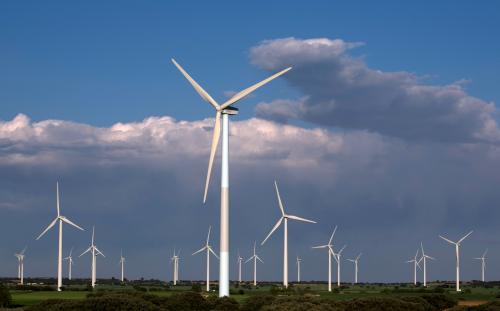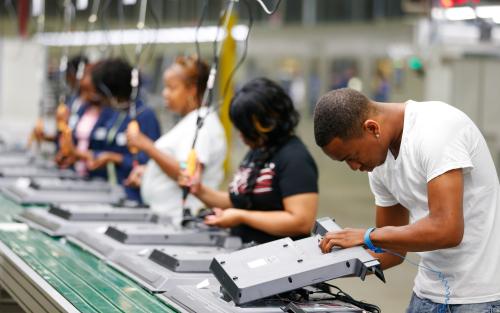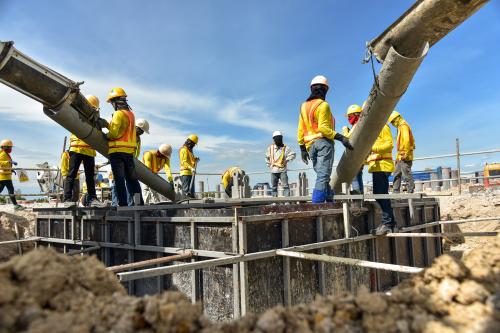The U.S. auto industry has rebounded well from its near collapse during the financial crisis.
Auto suppliers in particular have done well, increasing employment more than 50 percent since 2008. Central to all of this has been the creation of a single national standard for fuel economy—one that required the industry to meet increasingly stringent targets announced far in advance.
However, there’s now a problem: While tariffs and trade wars continue to dominate auto-sector headlines, the Trump administration has been pushing a quieter agenda to revise the successful fuel economy program. With key decisions remaining to be made, the administration’s actions–if not carefully crafted to secure support from both the industry and the state of California—could very well unravel a good portion of the auto sector’s gains.
The threat is real and potentially far-reaching. In 2012, the U.S. Department of Transportation (DOT), the U.S. Environmental Protection Agency (EPA), and the state of California (which has authority under the Clean Air Act to establish standards stricter than federal ones and that can then be adopted by other states) worked together to promulgate ambitious fuel economy standards for new cars and light trucks through 2025. Following the rescue of GM and Chrysler, which stabilized the entire domestic auto industry, these new standards were one component of a coherent strategy to facilitate investment in the auto sector, encourage innovation to improve American competitiveness, and ensure a clear and consistent regulatory framework that balanced costs and benefits consistent with environmental and economic objectives. The approach was widely supported by industry, labor, and environmental groups.
However, now comes the present faceoff. In March 2017, the Trump administration announced its intent to amend the 2022 to 2025 standards as part of a new federal rule-making. In itself that was not a deal-breaker, as the compromise reached in 2012 under the “One National Program” concept included a midterm review as an intermediate checkpoint to ensure that end-year standards remain ambitious yet achievable, and thus envisioned an opportunity for tweaking the standards for later years. However, in recent months, news reports have revealed what that meant: The federal government is considering freezing the emissions standards and challenging California’s authority to maintain its own stricter standards under the Clean Air Act.
The result has been a storm of concern from industry as well as environmental experts. Central to the agitation—articulated in a May 3 letter to the White House’s Office of Management and Budget from the Alliance of Automobile Manufacturers—has been the worry that the administration might upend the One National Program, which has provided automakers with regulatory clarity through its alignment of multiple federal and state regulators. Given that, President Trump—at the urging of automakers—directed his agencies to negotiate with California, which is welcome, so long as the government is committed to maintaining the single national standard.
And yet, while much of the focus has been on the needs of the major automakers, policymakers need to also take notice of the needs of the U.S. auto supply chain, which form the background of U.S. auto manufacturing and arguably of the nation’s advanced manufacturing base.
The U.S. auto supply chain, after all, employs some 1.5 million people: four times as many people as do U.S. auto manufacturers.
The U.S. auto supply chain, after all, employs some 1.5 million people: four times as many people as do U.S. auto manufacturers. Many of these workers are employed by small and medium-sized firms making components like piston rings, heat shields, and turbochargers—all products that are in increased demand due to the fuel economy standards. The failure of GM and Chrysler during the Great Recession would have decimated U.S. auto suppliers and in turn the U.S. auto sector. By contrast, the extraordinary rescue of GM and Chrysler in 2009 stabilized U.S. auto suppliers, while subsequent actions to enact a single set of fuel economy regulations with a long-term horizon helped provide the clarity needed to promote investment and innovation amongst suppliers.
The result has been a relatively vibrant auto sector. Since 2008, auto suppliers have increased their employment by more than 50 percent, in part due to investments in new technologies like those that helped automakers meet steadily increasing fuel efficiency standards. At the same time, the auto supply sector remains an important source of innovation in the U.S. Today the industry accounts for 40 percent of robot use, is a top user of new lightweight materials, and leads U.S. implementation of advanced operations methods, such as continuous improvement and just-in time-production (techniques that only recently have been diffused to other industries).
In this fashion, the motor vehicle industry—including the 200,000 employed in assembling cars and trucks—directly accounts for 13 percent of all U.S. manufacturing employment. Including workers employed at parts suppliers other than in the first and second tiers, suppliers of raw materials, and makers of general-purpose equipment used in the auto industry, this figure would easily double. Overall, then, it is safe to say that at least one-quarter of U.S. manufacturing employment is strongly tied to the automotive industry. Nor do the local economic benefits flow only to Detroit or a few states. Currently, the auto supply chain extends into hundreds of local economies in 45 states, including all along Interstate 75, which runs from Michigan to Georgia (see map).

All of which underscores that all Americans—and especially those whose communities depend on a vibrant auto sector—should be urgently hoping for an acceptable compromise between California and the federal agencies on fuel economy standards.
Most importantly, we offer three reasons to retain some form of the single-standard program with its steadily increasing stringency.
First, suppliers have already invested to retool facilities and design new products to meet automakers’ steadily increasing fuel efficiency demands. These increasing standards are good for suppliers, making it profitable for them to create new products such as low-friction lubricants, improved turbochargers, and high-voltage electric motors. The regulations require increased content per car—most of which comes from suppliers. This increased content, in turn, allows consumers to spend less on gasoline while contributing to a cleaner environment. Flat standards at 2021 levels would reduce the profitability of innovative fuel-efficient products, meaning that U.S. suppliers would be unable to recoup their investments, weakening their near-term financial position. Furthermore, this action could shift the balance in favor of low-cost, low-quality parts, which tends to favor parts imported from abroad.
Secondly, the potential for two separate standards in the U.S. market would likely weaken the competitiveness of U.S. suppliers. On one hand, California and the states that follow California’s regulations would maintain more stringent standards, while the other roughly 60 percent of the U.S. vehicle market would likely follow stagnant standards. This scenario would weaken U.S. suppliers’ ability to compete in either market. For example, making the product innovations required to meet increasingly stringent standards in the California-led market may require investing in engineers to redesign products using lighter-weight materials; a bifurcated standard would mean these firms would have many fewer vehicles over which to amortize these fixed costs. Similarly, U.S. firms could compete with suppliers from abroad in the stagnant portion of the market by automating processes, but again would have many fewer vehicles over which to spread costs. Thus, scale economies in fuel-efficient technologies would benefit overseas suppliers, particularly those competing in European and Asian markets with more stringent standards and higher fuel prices. In the remainder of the U.S. market, the reduced benefits of fuel-efficient technologies would relatively improve the position of lower-cost imports.
And finally, a failure to reach an agreement on a single standard will result in significant regulatory uncertainty, given the protracted ramifications of a multiyear legal battle between California and the Trump administration that would divert the attention of both manufacturers and the general public from developing innovative products that meet the needs of the 21st century. A prolonged legal wrangle would absorb time, money, and attention that would be better spent on innovation and could drive business out of the U.S., as some companies sought less contentious production environments. Furthermore, such uncertainty would result in disproportionate harm to the smaller and medium-sized firms that make up much of the supply chain, which would then need to weather the current period and likely limit capital investment in future product innovation due to uncertain future demands from customers. Ultimately, the U.S. suppliers could on average emerge less competitive against imports from both high- and low-wage nations.
A sensible resolution of the efficiency issue is important not only for the nation’s air quality, but also for the strength of the U.S. auto supply chain, which itself is critical to the strength of U.S. auto manufacturing and manufacturing as a whole. At a time when new automobile technologies hold remarkable promise, we need to decide whether the United States will aggressively compete to lead innovation in auto technologies that in turn will spill over into other industries, or whether we are willing to cede that innovation through shortsighted regulatory backsliding. Such a concession would slow innovation and undermine the suppliers that our auto industry relies upon. It would be a mistake.









Commentary
Why undermining fuel efficiency standards would harm the US auto industry
July 2, 2018